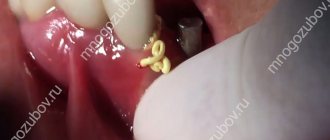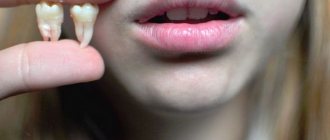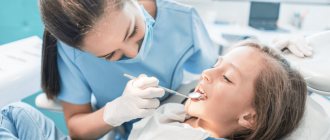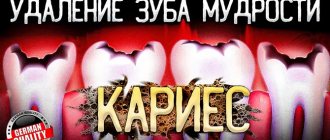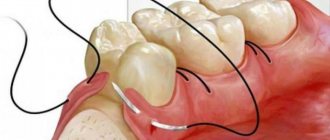Should wisdom teeth be preserved?
We think yes.
Although wisdom teeth are not involved in the process of chewing food, they can still benefit a person. There must be clear medical indications for their removal. And now we will provide you with another proof of the benefits of your own teeth-eights. Our patient Kim is about 20 years old, she is from Korea and lives in Moscow, as her parents work at the Korean embassy. I contacted the German Implantology Center due to inflammation of tooth 4.6 – the lower right six. The tooth was destroyed
, an abscess developed. There was a temporary filling on the tooth (placed in another clinic):
Where a temporary filling was placed, she was told to remove the tooth. That's why Kim came to us with one simple goal - to atraumatically remove the six, which began to greatly bother and hurt her. After doing a CT scan and looking at the tooth, we offered her an option, which, upon hearing, Kim at first did not believe her ears. Our proposal was to remove the six and immediately in its place... transplant its lower right wisdom tooth! This is called autotransplantation surgery.
When does teeth change?
Permanent teeth in a child’s body are formed approximately in the fifth month of intrauterine development, and by the time of birth, the gums contain almost fully formed rudiments of temporary and permanent teeth. The timing and order of their change may vary depending on a number of factors, including heredity, the quality of water and food, the presence of chronic diseases and the individual characteristics of the body. In addition, statistics say that this process begins earlier in girls than in boys.
Baby teeth begin to fall out around the age of 5 to 7 years, and permanent teeth appear in their place over time. The general order of appearance of molars is exactly the same as for milk teeth - they grow in pairs, starting from the lower jaw. The molars (sixes) appear first, but since they do not have milk “brothers”, they simply stand in line with the temporary teeth. The rest of the order of teeth growth is as follows.
Table. Approximate timing of teething.
| Names of teeth | Approximate period of eruption, years |
| Incisors in the center | 6-7 |
| Incisors on the sides | 7-8 |
| Fangs | 9-12 |
| First molars | 9-11 |
| Second molars | 10-12 |
The appearance of so-called wisdom teeth (or eighth teeth) occurs much later - around the age of 20, and in some people they do not appear at all. The growth rate of different teeth differs significantly - the front incisors grow the fastest, while molars and premolars have slow, difficult growth.
Deviations from the generally accepted timing and schedule for changing teeth should not cause panic among parents - most often this is simply a feature of the baby’s body. If the process is delayed too much (a permanent tooth does not appear in the place of the fallen one within 3-4 months), parents should consult a doctor to rule out the presence of diseases. Tooth growth may be delayed due to rickets or endocrine disorders, as well as due to pathologies associated with tooth formation. These include primary adentia and retention of permanent teeth: in the first case, the tooth germs in the tissues are completely absent, and in the second they are incorrectly located, which is why the tooth cannot cut through the tissues.
Wisdom tooth transplant as a way to replace a defect
Of course, Kim was very surprised, but we showed her photographs of successful operations (and we have all of them successful), apparently our persuasiveness and the patient’s desire played a positive role in making the decision to transplant the eighth tooth. She was happy and agreed to the operation.
Moreover, in this case we did not even have to make a stereolithographic model of the tooth, since all surgical procedures (extraction and transplantation) were performed on the very first day of her visit to our clinic.
Dental transplant surgeries typically require several days of preparation, as we describe in the following clinical case study. But in this case, taking into account the current clinical situation and relying on our many years of successful experience in tooth transplantation, we were able to transplant tooth 8 into the place of tooth 6 as quickly as possible. We had all the indications for current dental transplantation.
The donor was an impacted (completely hidden under the gum) wisdom tooth 48. In fact, as we joked, it was a neighbor tooth to the problematic six. That is, the tooth grew and grew for 20 years, waited in the wings, and that hour struck! Now this donor tooth is for another 30 years
at least he will live in a new place.
If you look at the sixth tooth from the side, you can see bluish, literally purple gums
:
This color of the gums is due to the developed inflammatory process. The patient developed destruction of bone tissue against the background of advanced periodontitis. There was a crack in the root of the sixth tooth.
Late restoration of extracted teeth
“When a tooth is missing, the remaining teeth shift towards the missing one. At a young age, this process occurs quite quickly and can create additional difficulties in subsequent prosthetics. Therefore, you should not hesitate in making a decision about prosthetics.”
Akhmedkhanov Said Rashidovich, Dental surgeon, general dentist, implantologist, orthopedic dentist, dental therapist, work experience 13 years
You can get a denture or implant at any time, even if several years have passed since the tooth was removed. But this may require additional material investments. If immediately after tooth extraction it is possible to carry out a one-stage implantation, avoiding serious damage to the gums and the need for a sinus lift, then if there is a lack of bone tissue, plastic surgery cannot be avoided. It will delay the completion of implantation by 4-6 months and lead to additional expenses. If the teeth have already shifted, then before implantation or prosthetics it is necessary to correct the bite with mouth guards or braces. Orthodontic treatment requires new material investments and takes additional time. On top, opposite the empty socket, there is an antagonist tooth. It gradually moves down and begins to stand out noticeably from the crowd. To eliminate this defect, it will be necessary to grind off the excess part. The tooth itself is protected with a crown.
The cost of implantation and prosthetics after a long period of time after tooth extraction will be 25-50% higher. Restoring the integrity of the dentition immediately is much easier, faster, safer and more affordable. We recommend contacting your dentist immediately after losing a tooth. Together with the dentist, it will be easy to choose the optimal method of prosthetics and implantation, which will allow you to quickly restore chewing functions and avoid both additional material costs and health problems.
The difference between transplanting your own tooth and implantation with a dental implant
By the way, for your transplanted tooth, the presence of an inflammatory process in the soft and bone tissues does not matter, because all the tissues there are their own and, naturally, the body will protect its transplanted tissues. That is, the body does not treat the transplanted tooth as “friend or foe,” which always happens in the case of tooth implantation with a titanium or zirconium implant.
If there is an inflammatory process, an artificial implant cannot be placed in this place. And you can put your own tooth, because it has the so-called. the ligament of the tooth that has all the cells that will fight.
Naturally, after the tooth extraction, we processed everything as much as possible, carefully cleaned and rinsed it.
In this photo we have begun to treat the wound. It can be seen that there was an inflammatory process in the gums, the bone tissue was partially but severely destroyed. Signs of bone tissue destruction are clearly visible on computed tomography:
By the way, even if the bone tissue is destroyed, when we transplant our own teeth, we do not need bone grafting; there is no need to replant additional bone. And that's why. The tooth itself nourishes and regenerates. Even if there were no front wall of the tooth, if there were no vestibular buccal wall, if you transplant such a tooth, then it is restored from its ligament, even the bone grows.
Therefore, if there is a choice between transplanting your own tooth and implanting a dental (titanium, zirconium) implant, it is better to opt for transplanting your own tooth.
Let's begin atraumatic wisdom tooth removal
In 40 seconds
We made an incision in the area of the donor tooth, which we planned to remove and replant in place of the previously removed six. We carefully removed the wisdom tooth, placing it in a saline solution for a short time:
Many people wonder: do wisdom teeth have roots? Yes, of course there is – this is a molar. We draw your special attention to the fact that this wisdom tooth 48 has not yet finished growing its own roots, its maturation is not yet complete. The growth zone of the root of the lower wisdom tooth is preserved and this tooth subsequently, after 2 weeks, does not require nerve removal! That is, it not only grows in, but also completely becomes accustomed to its nerve.
a powerful ligamentous apparatus he has.
, which provides high survival potential. Indeed, this tooth has taken root, and besides, it has a living nerve.
Transplantation of a wisdom tooth into place 4.6
The donor tooth was clearly placed in the place of the problematic sixth tooth. It was as if he had been there all his life: ideal external dimensions, the wisdom tooth was transplanted to the place of the removed one without any external grinding. Ideal autotransplantation operation.
The implanted tooth is tightly sutured
to ensure maximum tissue contact with each other and a normal healing process.
Did your child have a molar tooth removed? The orthodontist is already waiting...
Permanent teeth should ideally last a lifetime. But sometimes dentists are faced with the need to remove, as people say, a child’s “molar” tooth. This is done only as a last resort, when it is no longer possible to cure:
- advanced caries with tooth destruction of more than 70% and damage to the root;
- serious tooth trauma with root fracture;
- severe forms of periodontal pathology;
- untreatable purulent inflammatory processes.
Removing a permanent tooth in a child is a surgical procedure in which not just one of 32 teeth is removed, but a member that is very important for the balanced growth and functioning of the entire dental system. That is why dentists recommend not to go to extremes and regularly bring your child for preventive examinations at least 2 times a year.
Molars in children require more careful care than in adults. Frail enamel is susceptible to the effects of carious factors and the external environment, add to this a love of sweets and soda. Therefore, when children have their first permanent teeth (5
–
6 years), parents need to take special control over oral hygiene and diet, at least until the
14–15
, until the teenager begins to realize the importance of dental health.
Deleted and forgotten?
But no! Here everything is like in adults, a new tooth will not grow, and in place of the removed one there will be a gaping void. Many parents believe that they can leave everything as it is if the “hole” is not visible or the child is not embarrassed by it. And this is a fatal mistake, which in the future will result in expensive dental treatment and health problems.
This is exactly the situation faced by the girl Elena Badmaeva (name corrected), who had 2 chewing teeth removed at school age:
“I didn’t notice the problem for years, and I went on like this until I was 19 years old when I noticed that the neighboring teeth were leaning towards the missing ones, and the gums were sagging. My jaw began to click and pain radiated to my temple. The dentist immediately warned me that the treatment would not be easy or quick. As a result, I had to wear braces, undergo two surgical operations to restore the lost gum volume, and place implants. It took me 3 years and a tidy sum. But all this could have been avoided...
It is possible if you immediately contact an orthodontist after removal. Let us immediately warn you that you should not count on an implant, because they are placed only from the age of 18, after the end of active skeletal growth. Dentists have other methods for working with young patients.
For example, special spacer structures or temporary dentures that prevent teeth from shifting. As the bone tissue grows, the structures will be replaced so as not to disrupt the correct development of the facial skeleton. Well, when the child turns 18, he will be able to get implantation and prosthetics and will no longer remember about the ill-fated “lost” tooth.
– Observation by an orthodontist will eliminate the negative consequences of removing permanent teeth – displacement of adjacent teeth, uneven tissue atrophy, and other disorders of the dental system. In childhood and adolescence, maintaining or correcting minor changes in bite is much easier and faster. Timely treatment will allow you to avoid complex dental procedures in the future and save the family budget, warns Bato Vasiliev, chief physician of the Art Smile Dentistry Center.
Take care of the health of your children, monitor the condition of their milk and permanent teeth, so that in the future they only go to the dentist for preventive examinations.
And your children will thank you!
Art Smile Dentistry Center 69-777-0, 30-30-59 https://artsmile03.ru/ st. Klyuchevskaya 4/1
Author: Advertising INFPOL.RU
After autotransplantation 2 weeks
Patient Kim came to us after 2 weeks
for medical examination and suture removal:
Nothing bothered her anymore. The tooth had acceptable physiological mobility. The gums have become lighter. Of course, all the purple color is not gone yet, but she has already become more pink.
Pay attention to the white area - this is not pus, but fibrin plaque, which we will talk about in more detail below.
The picture shows that the donor tooth has clearly positioned itself in the position of the extracted tooth 46:
Our Kim has a new six molar. Both the patient and the medical staff of the Research Center are very pleased with the outcome of the tooth transplantation operation.
About fibrin and fibrin plaque
Fibrin
- a high-molecular, non-globular protein formed from fibrinogen, synthesized in the liver, in the blood plasma under the action of the enzyme thrombin; has the form of smooth or cross-striated fibers, the clots of which form the basis of a blood clot during blood clotting. Thus, fibrin promotes rapid wound healing by forming fibrin plaque.
Fibrin plaque
- a natural phenomenon that occurs in the oral cavity in the area of surgical intervention (at the site where a tooth was removed, stitches were applied, etc.). It occurs on the 3-4th day after surgery in the oral cavity. And this is one of the normal and inevitable stages of healing of a hole covered with a blood clot. This is followed by tissue restructuring, covering the wound with protective epithelium and restoration of normal mucosa.
Patients often confuse fibrin plaque with pus, causing them to worry and call their dentists.
Why does fibrin plaque occur?
Healing of a wound in the oral cavity occurs in a moist environment. If you have a cut on your skin, once the bleeding stops, the wound will be covered with a scab. We all know from childhood that this crust cannot be torn off. A blood clot covered with fibrin plaque is essentially the same “crust”, only in the mouth. And you can't touch her either! Otherwise, the healing process will take longer and the result will be less favorable.
There is no need to rinse out fibrin plaque!
After tooth extraction, tooth transplantation or dental implantation, intensive mouth rinsing is contraindicated, otherwise you may rinse out blood clots and fibrin plaque. As a result, painful sensations will appear, and the wound healing process will be worse.
Therefore there is no need to rinse
, and especially antiseptic and refreshing rinses, which often contain alcohol. However, the mouth can be washed. Make a kind of bath to wash away food residues. For this, a solution of chamomile or even simple black tea is suitable, which you just need to take into your mouth, hold for a while on the injured area and carefully spit out.
Features of the period.
At the age of 10, the replacement of primary chewing teeth and canines with corresponding permanent teeth begins: the 1st and 2nd premolars appear in the dentition in place of the primary molars. The permanent canine is the last one to erupt.
By the age of 12, a child completes the physiological replacement of milk teeth with permanent ones. By the age of 12, a teenager has 24 permanent teeth in the oral cavity: incisors, canines, 1st and 2nd premolars and 1st molar.
At the age of 13, the eruption of the second molar (7th tooth) begins.
By the age of 18 (and sometimes at an older age), the third molar, or “Wisdom” tooth, may begin to erupt.
